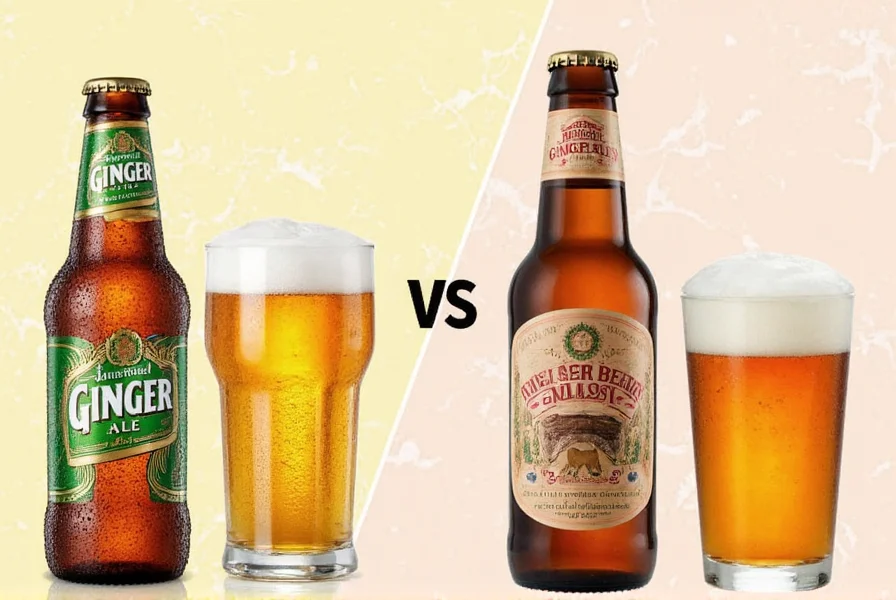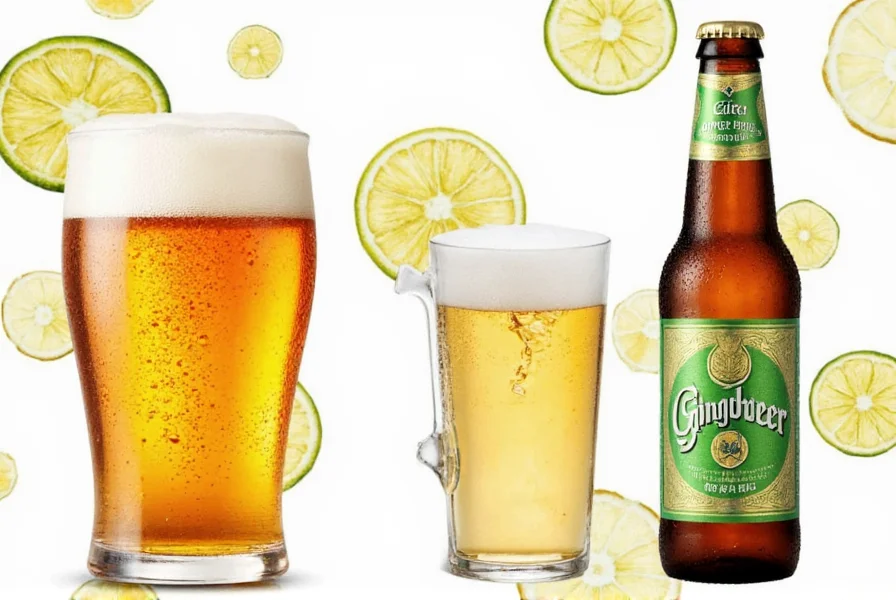The fundamental difference between ginger beer and ginger ale lies in their production methods: ginger beer is traditionally brewed and fermented, resulting in a stronger, spicier flavor and potentially containing up to 0.5% alcohol, while ginger ale is a carbonated soft drink made by mixing ginger flavoring with carbonated water, producing a milder, sweeter beverage with no alcohol content.
Many consumers confuse ginger beer and ginger ale because both feature ginger as their primary flavor component and share similar golden hues. However, these beverages have distinct histories, production processes, flavor profiles, and culinary applications that set them apart. Understanding these differences helps consumers make informed choices whether they're mixing cocktails, seeking digestive remedies, or simply looking for a refreshing beverage.
Historical Origins and Evolution
Ginger beer originated in 18th century England as an alcoholic beverage created through natural fermentation. Early recipes combined ginger, sugar, water, and a starter culture called "ginger beer plant" or "bead," allowing the mixture to ferment for several days. This traditional method produced a beverage with noticeable alcohol content, typically ranging from 2% to 11% ABV in historical preparations.
Ginger ale emerged later in the 19th century as a non-alcoholic alternative. Canadian pharmacist John McLaughlin created the first commercial version in 1851, developing a golden-style ginger ale that was stronger and more robust. Later, in 1904, Belfast-born chemist Thomas Joseph Cantrell developed the lighter, crisper "dry" or "pale" style of ginger ale that became popular in the United States.
Production Methods: Fermentation vs. Carbonation
The most significant technical difference between these beverages involves their production:
| Characteristic | Ginger Beer | Ginger Ale |
|---|---|---|
| Production Method | Brewed and fermented | Carbonated soft drink |
| Alcohol Content | Traditionally 2-11% (modern versions typically 0.5% or less) | Non-alcoholic (0% ABV) |
| Carbonation Source | Natural from fermentation | Artificially added |
| Ginger Content | Higher concentration of real ginger | Lower ginger content, often with artificial flavors |
| Taste Profile | Bolder, spicier, more complex | Milder, sweeter, less intense |
Traditional ginger beer undergoes a fermentation process where yeast consumes sugar to produce carbon dioxide and alcohol. Most commercial ginger beers today are either lightly fermented then pasteurized to stop fermentation (resulting in minimal alcohol content) or artificially carbonated to mimic the traditional product without alcohol.
Ginger ale, by contrast, is produced by mixing ginger flavoring (which may be natural or artificial), sweeteners, and other ingredients with carbonated water. No fermentation occurs in the production of modern ginger ale, making it a straightforward soft drink.
Flavor Profiles Compared
Ginger beer delivers a more intense ginger experience with noticeable heat and spice. The fermentation process creates complex flavor compounds that give traditional ginger beer a robust, sometimes slightly sour or yeasty note alongside the ginger's natural pungency. Craft ginger beers often showcase the true character of ginger with a warming sensation that lingers on the palate.
Ginger ale offers a milder, more approachable flavor profile. The golden style has a stronger ginger presence while the more common pale or dry style features a subtle ginger flavor with pronounced sweetness. Most commercial ginger ales prioritize refreshment over ginger intensity, making them more versatile as mixers but less distinctive in flavor.
Culinary and Cocktail Applications
The difference between ginger beer and ginger ale becomes particularly important when used in cocktails. The Moscow Mule, perhaps the most famous ginger-based cocktail, traditionally calls for ginger beer rather than ginger ale because its bolder flavor stands up to vodka and lime without being overwhelmed.
Cocktail enthusiasts seeking authentic flavor profiles should note that substituting ginger ale for ginger beer will significantly alter a drink's character. Ginger beer's spicier profile adds complexity to dark spirits like rum and whiskey, while ginger ale's mild sweetness complements lighter spirits and makes it a popular choice for the Jack and Coke.
Beyond cocktails, both beverages have digestive benefits, though ginger beer's higher ginger content may provide more pronounced relief for nausea. In cooking, ginger beer can add depth to marinades and glazes where its robust flavor won't get lost, while ginger ale works better in delicate sauces or as a base for lighter beverages.
Reading Labels: What Consumers Should Know
When purchasing these beverages, consumers should examine ingredient labels carefully. Authentic ginger beer will list ginger root or ginger extract among the first ingredients, while many ginger ales use "natural flavors" that may contain minimal actual ginger. The presence of yeast or fermentation byproducts on the ingredient list typically indicates a traditionally made ginger beer.
Alcohol content labeling varies by region. In the United States, beverages containing less than 0.5% alcohol by volume can be labeled as non-alcoholic, which applies to most commercial ginger beers today despite their fermented origins. Those seeking completely alcohol-free options should look for products specifically labeled as such.
Modern Craft Revival
Recent years have seen a craft beverage renaissance that has revitalized traditional ginger beer production. Small-batch producers are returning to the original fermentation methods, creating artisanal ginger beers with complex flavor profiles and noticeable (though still relatively low) alcohol content. These craft versions often use organic ginger, specialty sugars, and extended fermentation periods to develop nuanced flavors absent in mass-produced alternatives.

This craft movement has blurred some traditional distinctions, as some modern "ginger beers" are actually carbonated soft drinks capitalizing on the craft beverage trend. Consumers interested in authentic fermented ginger beer should look for products that explicitly mention brewing or fermentation in their descriptions.
Choosing Between Ginger Beer and Ginger Ale
Selecting the right beverage depends on your intended use:
- For cocktails requiring bold ginger flavor: Choose craft ginger beer for Moscow Mules, Dark and Stormys, or any drink where ginger should be a prominent flavor note
- For mild mixers or when ginger shouldn't dominate: Opt for ginger ale, particularly the dry style, in mixed drinks or when serving to children
- For digestive benefits: Select ginger beer with higher ginger content (check labels for ginger root extract as an early ingredient)
- For alcohol-sensitive individuals: Verify alcohol content, as some ginger beers may contain trace amounts
Common Misconceptions Clarified
Several myths persist about these beverages. Despite popular belief, not all ginger beers are alcoholic—most commercial versions contain minimal or no alcohol. Similarly, the notion that ginger ale is simply "weaker ginger beer" oversimplifies their distinct production methods. Another misconception suggests that golden ginger ale is the same as ginger beer, when in fact it's still a carbonated soft drink without the fermentation process that defines true ginger beer.
Conclusion
Understanding the difference between ginger beer and ginger ale enhances both culinary experiences and informed consumer choices. While modern commercial production has narrowed some traditional distinctions, the fundamental difference remains: ginger beer's fermented origin creates a bolder, more complex beverage, while ginger ale's carbonated soft drink production yields a milder, sweeter alternative. Whether you're crafting cocktails, seeking digestive relief, or simply enjoying a refreshing beverage, recognizing these differences ensures you select the right option for your needs.
Frequently Asked Questions
Is ginger beer alcoholic?
Traditional fermented ginger beer can contain alcohol (historically up to 11%), but most commercial versions today contain less than 0.5% ABV due to pasteurization that stops fermentation. Always check the label if alcohol content is a concern, as some craft versions may have higher alcohol levels.
Can I substitute ginger ale for ginger beer in cocktails?
You can substitute them, but the drink's character will change significantly. Ginger beer provides a spicier, more robust flavor that stands up to strong spirits, while ginger ale offers milder sweetness. For authentic Moscow Mules or Dark and Stormys, ginger beer is preferred for its distinctive ginger kick.
Which has more real ginger: ginger beer or ginger ale?
Generally, ginger beer contains more actual ginger root extract than ginger ale. Craft ginger beers often lead with ginger as a primary ingredient, while many commercial ginger ales use minimal ginger and rely on artificial flavors. Check ingredient lists for "ginger root" or "ginger extract" near the beginning to identify products with higher ginger content.
Why does ginger beer taste spicier than ginger ale?
Ginger beer's spicier taste comes from both higher ginger concentration and the fermentation process, which develops complex flavor compounds. The natural carbonation from fermentation also enhances the perception of ginger's heat. Ginger ale, being artificially carbonated with less ginger, produces a milder, sweeter profile that lacks the warming sensation of authentic ginger beer.
What's the difference between golden and dry ginger ale?
Golden ginger ale (also called original style) has a stronger ginger flavor, amber color, and slightly cloudier appearance. Dry or pale ginger ale is lighter in color, milder in flavor, and more carbonated. Canada Dry popularized the dry style in the United States, while golden style remains more common in Canada and the UK. Neither style is fermented like traditional ginger beer.











 浙公网安备
33010002000092号
浙公网安备
33010002000092号 浙B2-20120091-4
浙B2-20120091-4